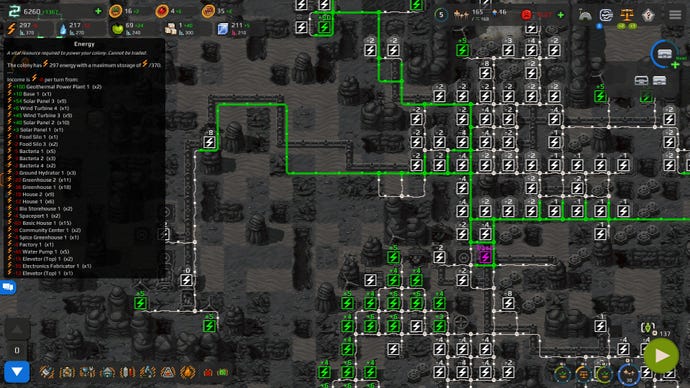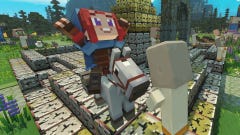Farlanders review: a Martian city builder that’s rather rocky
More work than rest or play
Have you ever been in a relationship with somebody who surprised you in all the right ways at the beginning, but eventually frustrated and disappointed you so deeply that it all ended in a messy breakup? Farlanders is my messy breakup.
It's a space colony city builder with a puzzle game mentality - and set on Mars to make things even more enticing. The best part of Farlanders is its story, and while it’s not quite a full-blown commentary on colonialism, it examines what you’re doing and why you’re doing it with a self-awareness that I did not expect at all. That being said, annoying difficulty curves, awkward terraforming, and frustrating progression systems stop this space colony sim from really taking off. A graph charting my enjoyment over time would look like a child’s drawing of a mountain.
Let’s start with the good stuff. The story and the telling of it are easily the two best aspects of Farlanders. You play as Marco, a Martian citizen and vlogger, who makes videos about his new job as Mars' official colony architect. However, over time, Marco begins to realise that this job isn't all it seems to be when videos begin to spring up online about how the company he's working for is not to be trusted. Soon, Marco’s wide-eyed enthusiasm and naivety, accelerated by the prospect of moving to a whole new planet, is slowly worn down, the turning point being when he helps a colleague with an unsanctioned experiment that causes disaster for a large number of people living on Mars.
I loathe to give many more details as the story is tightly written and there isn’t very much of it. Visual novel-style conversations, entertaining and pleasingly realistic text chats and vlog comment sections (as well as the vlogs themselves) give the impression of this all happening in a larger world where your actions are being constantly questioned. It ultimately boils down to: What right do you have to change the face of a planet, expending huge amounts of its natural resources for very little gain?
In between the storytelling, of course, is the actual developing a colony on Mars bit. This is a turn-based city builder, in that you need to click a button to commit to the decisions you’ve made and things you’ve built for time to pass. You can take as long as you need to think about your next move, without having to worry about all the little electronic people guzzling up your resources while you do so. It’s not often you see this in city builders and it’s great. It makes proceedings feel like you’re playing Martian space chess.
.jpg?width=690&quality=80&format=jpg&auto=webp)
The first thing you do on any map is plop a base down somewhere. Each map is fairly small, but works on a grid system, and is procedurally generated. You sort of know what each map will look like - minerals and water here and there, oddly phallic mountains all over the place, etc - but the precise layout is unpredictable. Everything needs to be connected to your base in one way or another. Power sources need to be wired to it, houses and factories will also need water pipes and tunnels leading to it; logical, easy to understand stuff.
"Marco’s wide-eyed enthusiasm and naivety, accelerated by the prospect of moving to a whole new planet, is slowly worn down"
The more your colony expands and the greater the demand on your resources, the trickier it becomes to balance what you should build and where. Should I surround a water source with greenhouses for food, or stick a water pump on top for water? Or maybe I should build a swimming pool (yes, a swimming pool on Mars) to increase happiness? Again, pretty standard city-building stuff. Some of the internal logic is bizarre, though. Build a park, and it closes every time you run out of spices. Erm, why?
I could moan about the landing platforms attached to the base, too. Hell, I will, briefly. Bigger deliveries of resources you buy and larger batches of colonists that you attract require more platforms. Sure, I get that. But how do a handful of teeny tiny people take up the same amount of space as the number of materials required to build an entire factory? What are they taking in their luggage, spare space shuttles?
.jpg?width=690&quality=80&format=jpg&auto=webp)

.jpg?width=690&quality=80&format=jpg&auto=webp)
The real problem, in a few ways, is how colony happiness works. As more people move in, the general happiness level slowly rises. Great! Once you hit a certain number of colonists, however, colony size results in a decrease in happiness, as everybody suddenly becomes a miserable antisocial bastard demanding entertainment facilities in order to maintain some semblance of pleasure in their lives. Once colony happiness decreases, it plummets at an alarming rate, and bringing it back up again is one of the game’s greatest challenges. Each level’s success state is reaching a certain colony size and nobody wants to join you while your current citizenry is as happy as a Tesla shareholder.
"Each level’s success state is reaching a certain colony size and nobody wants to join you while your current citizenry is as happy as a Tesla shareholder"
We’re on Mars here though, remember? Much of the terrain isn’t suitable for building on, and this proved to be one of the fundamental causes of my occasional primal screams of anguish. The good news is, tools are available to change the status of terrain. Dig up the ground to make it usable, say; blow up a mountain, fill in a canyon, or create a lake. The bad news is, the tools you’re given are pretty sporadic and many require specific types of terrain combinations to be used. And, especially early in a colony’s development, you are entirely at the RNG’s mercy when it comes to which tools you get. Oh - and it’s not guaranteed that you’re given a new one on every turn, either. The food, water, electricity, and cash cheerily marching out of your reserves won’t wait for the turn where the right tool finally arrives. There’s a time limit on the standard campaign difficulty, too.
Speaking of which, the campaign consists of just seven missions/maps, and by mission five or six, the difficulty curve suddenly becomes a cliff face that dares you to even think about climbing it. The enormous population figures you need to hit are guaranteed, but your chances of being able to do what you know is necessary are not. On one occasion, I was running desperately low on water, but the game refused to give me a water creation tool. By the time I had one, I’d hit a point of no return, and saw failure thundering toward me.

Crucially, things simply aren’t explained very well. A lot of very important information is buried within walls of text in the pause screen, and even hitting your head against that won’t quite cover everything. This is a major issue because Farlanders soon becomes an incredibly challenging experience, and it’s easy to fail a dozen turns before you realise it’s even happened. There’s a Free Play option, but without playing the campaign with its 'tutorial’ first, it would be like frisbeeing the instruction manual out of a window before flying a spaceship.
I also hit two bugs at critical points (once new technology unlocked only partly, on another occasion new colonists couldn’t join when they should have been able to) which led to each of those sessions falling apart. A post-launch update will unlock a sandbox mode, and I’m hopeful that this will surrender more control to the player, bringing Farlanders closer to its full potential. As it stands you’ll need not only a wealth of city building experience, but also - more importantly - a bottomless well of patience in order to fully enjoy this space colony sim.











